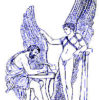
Your Life as a Myth Part 3
The following is the third installment of a three-part series on the use of myths and archetypes in memoir writing. In this first post of Your Life as a Myth, I wrote about both archetypal patterns in general and about the martyr archetype. In the second post, I wrote about the orphan and the martyr. These posts are excerpted from Turning Memories Into Memoirs / A Handbook for Writing Lifestories.
In the first installment of Your life as a Myth I wrote about the martyr archetype and in the second installment, I wrote about the orphan and the prince-left-at-the-pauper’s-door. Today, I will offer you some practical suggestions for implementing the concept of archetypes in your memoir writing.
Writing from the perspective of personal myths can explain a lot about the stories you are recording. In addition, consciously living archetypes in your own life and turning them into positive forces is a rewarding path for self-growth. [Free Membership required to read more. See below. ]
We'd love to have you access this content. It's in our members-only area, but you're in luck: becoming a member is easy and it's free.
Already a Member?
Not a Member Yet?

Your Life as a Myth Part 2
The following is the second installment of a three-part series on the use of myths and archetypes in memoir writing. In the first part of Your Life as a Myth, I wrote about both archetypal patterns in general and about the martyr archetype. In today’s post, I write about the orphan and the prince-left-at-the-pauper’s-door. Both frequently make appearances in a memoir. These posts are excerpted from Turning Memories Into Memoirs / A Handbook for Writing Lifestories.
What is the orphan archetype?
One example of myths and archetypes is the orphan. People who do not develop or maintain personal ties can be said to be pursuing the orphan archetype. Artists are an example of the positive side of this archetype. Because many artists feel detached from roots, family, etc., they are free to tell the truth as they see it, to risk much in the pursuit of their art. [Free Membership required to read more. See below. ]
We'd love to have you access this content. It's in our members-only area, but you're in luck: becoming a member is easy and it's free.
Already a Member?
Not a Member Yet?

Your Life as a Myth Part 1
The following is the first installment of a three-part series on the use of myths and archetypes in memoir writing. In this first post of Your Life as a Myth, I write about both archetypal patterns in general and about the martyr archetype. In the second post, I write about the orphan and the martyr. In the third post, I write about general considerations of using myths and archetypes. These posts are excerpted from Turning Memories Into Memoirs / A Handbook for Writing Lifestories.
Myths are the stories we create to express how we perceive the world and life. How we live our lives is determined by the myths we live by, but our lives also reveal our myths to ourselves and to the world.
What are your myths? Look at your life, at your feelings, at your responses to others. That is where your myths reside! That is where your life as a myth can be found. [Free Membership required to read more. See below. ]
We'd love to have you access this content. It's in our members-only area, but you're in luck: becoming a member is easy and it's free.
Already a Member?
Not a Member Yet?

Going Beyond Family Myths to What Really Happened
Family myths aren’t always true. Your family myths may be stories your people choose to tell about themselves regardless of what really happened. Myths are stories we tell about how the world seems to us to be organized. Most of us are familiar with the religious myths Greeks and Romans told as they sought to […]

Use this instead of a writing prompt…
Writing prompts lead to nothing
As readers of the blog know, I’m not a great fan of using a writing prompt. Sure, they get you to writing something and many will insist, “Writing something is better than writing nothing…”
Well, I’m not so sure of that. Writing should matter. It’s hard work, and life is short. What’s better than nothing about writing some text on “the most fun things I did this summer?” as we sometimes had to in school. (No wonder we did not learn to write while in that context!)
Writing from insipid prompts is not much better than writing nothing—not if you are someone who is interested in writing “from the inside out” as I hope all readers of this newsletter are. [Free Membership required to read more. See below. ]
We'd love to have you access this content. It's in our members-only area, but you're in luck: becoming a member is easy and it's free.
Already a Member?
Not a Member Yet?

Use an archetype of your experience to revive your memoir
Can an archetype of your experience refocus your memoir? “My memoir writing has grown tedious,” you bemoan. “I thought what I was writing about was exciting when I began writing. It was exciting then. I could remember so much of what happened. It was compelling. And now as the time I lived this experience recedes into the past, as the vivid memories become less vivid, I am finding it hard to continue to write. Should I give up?” [Free Membership required to read more. See below. ]
We'd love to have you access this content. It's in our members-only area, but you're in luck: becoming a member is easy and it's free.
Already a Member?
Not a Member Yet?

Should You Write With An Audience in Mind?
While some people decide to write a memoir according to structure—healing memoirs, investigative memoirs, etc—as I wrote in a previous post, others write with an audience in mind. (Writing with structure in mind often calls for writing with an audience in mind, also.) Sometimes the audience is of specific people but many other writers, while they do have a specific audience in mind, are really writing to a group according to their interest.
“I want to write for my kids and grandchildren. I want them to know who I was,” one sort of memoirist will realize. While another will think, “I want to my children and grandchildren to know me, too, and I want to place my life in a greater context. I’m hoping to have readers beyond my kin, readers who are interested in a larger picture of what life was.” [Free Membership required to read more. See below. ]
We'd love to have you access this content. It's in our members-only area, but you're in luck: becoming a member is easy and it's free.
Already a Member?
Not a Member Yet?

When You Must Have The Photos You Don’t Have/How To Journal Without The Photos, Part II
What to Do When There Are No Photos
The Memory List that you completed when you first began writing your memoir is integral to the writing process. The Memory List will suggest topics to write about, but what follows is additional tips you can use when you don’t have the photos. [Free Membership required to read more. See below. ]
We'd love to have you access this content. It's in our members-only area, but you're in luck: becoming a member is easy and it's free.
Already a Member?
Not a Member Yet?

The Problem With Writing Prompts
Is there a problem with writing prompts? This is my issue with writing prompts: they tend to lead to isolated stories, stories that are searching for humor, searching to be shared with a group that is perhaps looking for entertainment. They are not, by and large, searching for meaning lost in the morass of your […]
